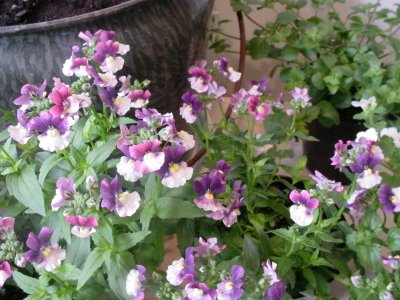 These little specimens, 'Berries and Cream Sachet' in the Nemesia family are going to go into a pot today. I've got several 'Abunda Giant White' Bacopa to settle in with them. If you've never tried Bacopa and Nemesia together, you are in for a real treat. They are great performers, with abundant blooms all summer. When the weather permits, they will go out on the patio, where they cherish sunshine.
These little specimens, 'Berries and Cream Sachet' in the Nemesia family are going to go into a pot today. I've got several 'Abunda Giant White' Bacopa to settle in with them. If you've never tried Bacopa and Nemesia together, you are in for a real treat. They are great performers, with abundant blooms all summer. When the weather permits, they will go out on the patio, where they cherish sunshine.

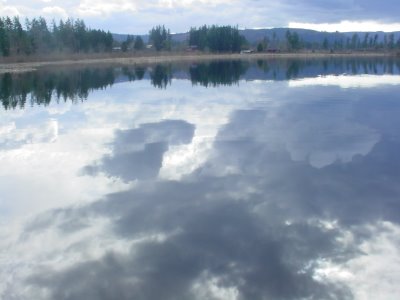 We almost didn't go on this paddle!
We got together with some friends Saturday morning, and thought the weather was not favorable for a paddle. The sky looked very ominous, with the threat of rain and hail (both were visitors the previous two days.) But, sunbursts broke through the purple clouds a few times, there was no wind, and that was invitation enough for me. I said, "Lets give it a try."
This trip I brought both video and still camera, with batteries charged, and a new cassette in the cam corder. I'll have to say that because it was so late in the day, the colors were very deep. From start to finish, I had images of dramatic sky and still water, quaint little cabins, fishermen in houseboats, and everything supremely tranquil. Even the waved greetings from fishermen seemed slow, and so welcoming. It was a blissful little lake.
I thought, if I could have a cabin, it would be here, on Lawrence Lake. I could just imagine something nestled in the woods, a fire going, and a nice bowl of hot chilli and bread.
We paddled around a corner of the lake, and we saw something exactly as I had imagined, only it was all boarded up, no smoke coming out of the chimney, and it looked like it had been abandoned years ago. Or, maybe it was a fort or hide-out for a bunch of kids. Blackberry brambles covered the walls, moss lined the roof, and the front door was wide open. It was rather a shame, because on this little corner of the shoreline there was a most exquisite view of the mountains. Someone long ago had surely picked a perfect spot for a cabin.
Our paddle lasted about two hours, with the redwinged blackbirds calling back and forth - and the frogs too.... a virtual symphony of chatter and croaks along the cattails. This is a 339 acre rainbow and brown trout lake, with carp who swim away in a rush of violent, swirling water. Other than that, the water rippled only as George's paddle dipped into it.
I filmed the entire paddle, with breaks to capture only the highlights. About a 30 minute film, it is the most beautiful of anything I've yet done. Most striking were the silver swirls in the water, laced by playful swirls of deep purple whirls. Each time George put his paddle in the water it changed the patterns.
We almost didn't go on this paddle!
We got together with some friends Saturday morning, and thought the weather was not favorable for a paddle. The sky looked very ominous, with the threat of rain and hail (both were visitors the previous two days.) But, sunbursts broke through the purple clouds a few times, there was no wind, and that was invitation enough for me. I said, "Lets give it a try."
This trip I brought both video and still camera, with batteries charged, and a new cassette in the cam corder. I'll have to say that because it was so late in the day, the colors were very deep. From start to finish, I had images of dramatic sky and still water, quaint little cabins, fishermen in houseboats, and everything supremely tranquil. Even the waved greetings from fishermen seemed slow, and so welcoming. It was a blissful little lake.
I thought, if I could have a cabin, it would be here, on Lawrence Lake. I could just imagine something nestled in the woods, a fire going, and a nice bowl of hot chilli and bread.
We paddled around a corner of the lake, and we saw something exactly as I had imagined, only it was all boarded up, no smoke coming out of the chimney, and it looked like it had been abandoned years ago. Or, maybe it was a fort or hide-out for a bunch of kids. Blackberry brambles covered the walls, moss lined the roof, and the front door was wide open. It was rather a shame, because on this little corner of the shoreline there was a most exquisite view of the mountains. Someone long ago had surely picked a perfect spot for a cabin.
Our paddle lasted about two hours, with the redwinged blackbirds calling back and forth - and the frogs too.... a virtual symphony of chatter and croaks along the cattails. This is a 339 acre rainbow and brown trout lake, with carp who swim away in a rush of violent, swirling water. Other than that, the water rippled only as George's paddle dipped into it.
I filmed the entire paddle, with breaks to capture only the highlights. About a 30 minute film, it is the most beautiful of anything I've yet done. Most striking were the silver swirls in the water, laced by playful swirls of deep purple whirls. Each time George put his paddle in the water it changed the patterns.
 My son Taraz has a couple of young ladies who do his essential mending projects. This was one of several.... ain't that a wild patch?I hope this little gal does not become a surgeon.
My son Taraz has a couple of young ladies who do his essential mending projects. This was one of several.... ain't that a wild patch?I hope this little gal does not become a surgeon.
 I'll have to admit: I'm not a breakfast person. After my morning coffee, with half and half and sugar, I've got power to last until 10:30, and that's when I have my first real meal of the day. Frequently it is a lima bean salad, with hummus and peta bread on the side. (Click on image to enlarge.)Perhaps I just need to really sit down and relax after doing morning housework, and 10:30 is a good time to break away. I do know one thing, I'm chewing for a good 25 minutes.....Salads are peaceful pastimes.To make this little ditty, just start with fresh baby spinach leaves, shredded carrots and broccoli, and mixed greens. Add finely chopped cilantro, celery, and red onion. If you've got them, add a few tomato slices or cucumber. Add a salad seasoning that has pepper, lemon and lime, dill weed, tarragon and basil and garlic. We've got a mixture like this called "Seafood Seasoning, and it's got sesame seeds in it too. Quite versatile.Then, add coleslaw dressing to the beans (canned limas shown here, but you can use any kind of bean, like fava, or a mixture of them) and mix separately from the other salad ingredients. Pour this mixture over the salad greens, and add a touch of green onion to garnish. Sprouts, like mung bean are quite pleasant as a garnish too - and I've sprouted my own in the past. (I've also grown those huge fava beans, too.) The shredded carrots are my own experiment. I mix a little red wine vinegar and honey, a little water, cover and microwave for 6 minutes - because I like them slightly cooked, not raw. I make up a big batch of these separate three salads - the tossed greens, the beans, and the carrots, and I have them for a meal every day if possible.
I'll have to admit: I'm not a breakfast person. After my morning coffee, with half and half and sugar, I've got power to last until 10:30, and that's when I have my first real meal of the day. Frequently it is a lima bean salad, with hummus and peta bread on the side. (Click on image to enlarge.)Perhaps I just need to really sit down and relax after doing morning housework, and 10:30 is a good time to break away. I do know one thing, I'm chewing for a good 25 minutes.....Salads are peaceful pastimes.To make this little ditty, just start with fresh baby spinach leaves, shredded carrots and broccoli, and mixed greens. Add finely chopped cilantro, celery, and red onion. If you've got them, add a few tomato slices or cucumber. Add a salad seasoning that has pepper, lemon and lime, dill weed, tarragon and basil and garlic. We've got a mixture like this called "Seafood Seasoning, and it's got sesame seeds in it too. Quite versatile.Then, add coleslaw dressing to the beans (canned limas shown here, but you can use any kind of bean, like fava, or a mixture of them) and mix separately from the other salad ingredients. Pour this mixture over the salad greens, and add a touch of green onion to garnish. Sprouts, like mung bean are quite pleasant as a garnish too - and I've sprouted my own in the past. (I've also grown those huge fava beans, too.) The shredded carrots are my own experiment. I mix a little red wine vinegar and honey, a little water, cover and microwave for 6 minutes - because I like them slightly cooked, not raw. I make up a big batch of these separate three salads - the tossed greens, the beans, and the carrots, and I have them for a meal every day if possible.
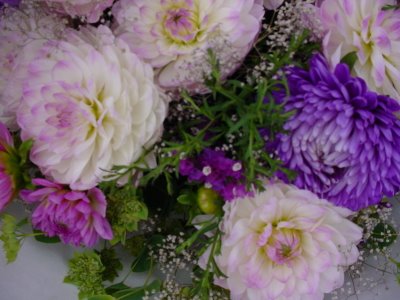 George and I spent the weekend cleaning up the yard and getting the garden-beds ready. We also took out the rabbit hutch that I made about 6 years ago when I had my rabbits, chickens and pygmy goats.
George and I spent the weekend cleaning up the yard and getting the garden-beds ready. We also took out the rabbit hutch that I made about 6 years ago when I had my rabbits, chickens and pygmy goats.
We double-dug a long growing bed along the fence for a cottage garden, and made eight berms for the vegetables. Each berm is about five feet square, allowing easy access to every plant. This is an intensive gardening trick I experimented with for about 15 years here in Tacoma.
Because we get a lot of rain, digging a trench and piling the soil up into a berm allows rainwater to seep into the trench. This pulls excessive water away from the seedlings so they will not rot. It helps to drain moisure into a trench lined with old straw, decomposed leaves, and grass compost. That way, if it rains hard, it becomes a nutritious 'grass soup'.
This 'grass soup', called 'Green Tea', will provide fertilizer for summer as more grass and weeds are composted in the trench. The technique requires 'double digging', turning soil up and over after the initial digging, to mix the lower strata with the upper portion. But, the benefit here is that the richest soil is underneath six inches, so summer-weary plants get a real boost of nutrients when they need it the most, when they are putting out their 'seed'. Because of the abundant organic material, I've never had to use artificial fertilizers other than a little steer manure.
To conserve on water, in mid summer, I'll apply a mulch of grass clippings and leaf clippings, to hold in moisture. That way, the berms are protected from heat and water loss on top and on the sides. As I weed, I throw the material in the berm I'm standing in, and it becomes composted through the summer. By season's end everything I've grown becomes composted.
It is mighty hard work - and the muscles in my arms are still sore. But the good news is that my shoulders held up real well, and that is a sign that the cartiledge is improving: I've been taking Glucosamine and Chondroitin, with MSM and Ester-C for about a year now. It has improved my joints.
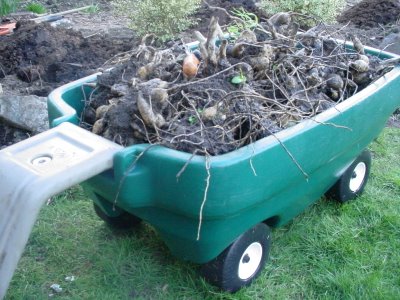 We've dug up all my Dahlia tubers for transplanting. This is something we do in the spring - I cut most of these bundles into 4 or 5 'eyes', and new plants start from them. Problem is, I've cut back on my Dahlias, to just a few, and with all the eyes, I've got about 200 more tubers than I really need. Each one is worth a couple of dollars if bought separately at the nursery. Now, what to do with all the rest.....I've had George do all the digging this year, as I just don't want to trigger my tendonitis again - ever! Seems like whenever I hold a digging fork, my shoulders pay a price for it the next day. So, he is getting the excercise this year. We are digging out some of my old perennial flowerbeds also, and removing old woody plants. I'll put some of the Dahlia tubers there this year, then decide in the fall how I want to continue with the garden. This summer I'm planning a kitchen garden along my fence, so I can have substantial herbs, tomatoes, beans, onions, spinach and lettuce. I like to make my own tomato sauce in the fall, and it takes at least 6 good tomato plants to pull it off well.Now that I'm retired, I want to spend most of my time outside when the weather is warm, either working in the yard, walking and hiking, or getting out on the water. (The wintertime is for art projects and blogging, which will probably take a back seat for awhile while I get things going.) Anyway, I always love this time of year - it is worth waiting all winter for, and it has finally arrived.
We've dug up all my Dahlia tubers for transplanting. This is something we do in the spring - I cut most of these bundles into 4 or 5 'eyes', and new plants start from them. Problem is, I've cut back on my Dahlias, to just a few, and with all the eyes, I've got about 200 more tubers than I really need. Each one is worth a couple of dollars if bought separately at the nursery. Now, what to do with all the rest.....I've had George do all the digging this year, as I just don't want to trigger my tendonitis again - ever! Seems like whenever I hold a digging fork, my shoulders pay a price for it the next day. So, he is getting the excercise this year. We are digging out some of my old perennial flowerbeds also, and removing old woody plants. I'll put some of the Dahlia tubers there this year, then decide in the fall how I want to continue with the garden. This summer I'm planning a kitchen garden along my fence, so I can have substantial herbs, tomatoes, beans, onions, spinach and lettuce. I like to make my own tomato sauce in the fall, and it takes at least 6 good tomato plants to pull it off well.Now that I'm retired, I want to spend most of my time outside when the weather is warm, either working in the yard, walking and hiking, or getting out on the water. (The wintertime is for art projects and blogging, which will probably take a back seat for awhile while I get things going.) Anyway, I always love this time of year - it is worth waiting all winter for, and it has finally arrived.
 A confused turnip? A spindly cabbage? Kohlrabi doesn't look like a culinary treat, but the bulbous stem--the principal edible part--can be eaten raw or cooked; it has a mild radish-turnip flavor and crisp texture. The young leaves taste like a delicate cabbage. I took this photo at the Farmer's Market last summer, and I'm considering putting a few in my garden this year, if I can find them at the nursery.
A confused turnip? A spindly cabbage? Kohlrabi doesn't look like a culinary treat, but the bulbous stem--the principal edible part--can be eaten raw or cooked; it has a mild radish-turnip flavor and crisp texture. The young leaves taste like a delicate cabbage. I took this photo at the Farmer's Market last summer, and I'm considering putting a few in my garden this year, if I can find them at the nursery.
 What a gorgeous sunny weekend we had here in Puget Sound! And, what a change it was from mid-week, when we had a few snow flurries. We decided to take advantage of the sunshine and head out onto into the country for a drive and a canoe paddle in Thurston County.Frye Cove, on the westside of Eld Inlet is a pleasurable place to lazily paddle and explore. There are little mid-inlet coves and southern tidal estuaries, perfect places to explore. Bluffs rim most of this area of Puget Sound. Many bluffs are made of glacial and interglacial sediments - layers of sand, cobble, and clay. Eroding bluffs provide most of the building materials and nesting places for shorebirds. You can see lots of holes in the wall-facings, where birds have had nests. Sediment or eroded "bluff stuff" drops to the base of the bluffs, where it is gradually carried along the shore by wind and waves. These bluff sediments help build shore forms such as spits, tombolos, and barrier beaches.The tide was out about 30 feet when we set out, so the beach was rich with shells. This area had submerged mesh traps for clams and mussels. The area boasts Butter Clams, Eastern Soft-shell, Bent Nose, Manila Clams, Mussels, and Pacific Oysters. During our entire paddle we saw a number of small fishing operations along the bank, but very few homes. The cliffs along the shoreline had become compromised, with many of the old trees plunged into the water, covered in barnacles. We had a very tranquil, sunny paddle, with gentle water. At one point I had to remove my coat as I got too warm. I was certainly counting my blessings - thinking that most people don't do this kind of thing, just glide along the water's edge to enjoy the day. George and I talked about the benefits of getting out into nature, of taking time away from the rush of activities, to gear down, and appreciate where we live. After five years of paddling together almost every weekend, we've got a system together, to manage all kinds of water conditions, weather, and portaging. Very little of it even requires much consultation - it is done instinctively now, keeping words to a minimum. I like this, because the sounds of nature are waiting to be heard.We paddled close to shore, so the images underwater were quite clear. As we approached the Frye Cove State Park a little boy was walking with his father along the shoreline. They waved to us from the hillside, and the boy said to his dad, "Hey Dad, look! They're on their honeymoon!"
What a gorgeous sunny weekend we had here in Puget Sound! And, what a change it was from mid-week, when we had a few snow flurries. We decided to take advantage of the sunshine and head out onto into the country for a drive and a canoe paddle in Thurston County.Frye Cove, on the westside of Eld Inlet is a pleasurable place to lazily paddle and explore. There are little mid-inlet coves and southern tidal estuaries, perfect places to explore. Bluffs rim most of this area of Puget Sound. Many bluffs are made of glacial and interglacial sediments - layers of sand, cobble, and clay. Eroding bluffs provide most of the building materials and nesting places for shorebirds. You can see lots of holes in the wall-facings, where birds have had nests. Sediment or eroded "bluff stuff" drops to the base of the bluffs, where it is gradually carried along the shore by wind and waves. These bluff sediments help build shore forms such as spits, tombolos, and barrier beaches.The tide was out about 30 feet when we set out, so the beach was rich with shells. This area had submerged mesh traps for clams and mussels. The area boasts Butter Clams, Eastern Soft-shell, Bent Nose, Manila Clams, Mussels, and Pacific Oysters. During our entire paddle we saw a number of small fishing operations along the bank, but very few homes. The cliffs along the shoreline had become compromised, with many of the old trees plunged into the water, covered in barnacles. We had a very tranquil, sunny paddle, with gentle water. At one point I had to remove my coat as I got too warm. I was certainly counting my blessings - thinking that most people don't do this kind of thing, just glide along the water's edge to enjoy the day. George and I talked about the benefits of getting out into nature, of taking time away from the rush of activities, to gear down, and appreciate where we live. After five years of paddling together almost every weekend, we've got a system together, to manage all kinds of water conditions, weather, and portaging. Very little of it even requires much consultation - it is done instinctively now, keeping words to a minimum. I like this, because the sounds of nature are waiting to be heard.We paddled close to shore, so the images underwater were quite clear. As we approached the Frye Cove State Park a little boy was walking with his father along the shoreline. They waved to us from the hillside, and the boy said to his dad, "Hey Dad, look! They're on their honeymoon!"

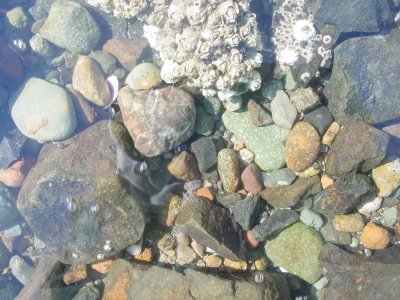 I walked along this beach while George was loading up the canoe. It was a good clamming beach - little puffs of sand around an entrance hole were dotted all over the beach. The photo of the rocks was an underwater area, with rocks covered in barnacles. A tidal pool is a fascinating place - like peeking into another world.When the tide is out along Puget Sound, the intertidal zone is revealed. Each tide pool holds a pocket of special plants and animals adapted to daily changes in temperature, moisture, oxygen, food sources, and predation. The tides on Puget Sound rise and fall twice a day, generally including two unequal high tides and two unequal low tides. In Puget Sound, the tide rushes through narrow channels and around islands creating rapids and eddies like a whitewater river. It is important for boaters and beach explorers to know what the tide is doing. Some waters are not navigable at low tide and some beaches may also be hazardous. We saw a harbor seal poke his head up at us as we paddled along here. He looked at us only one time, his curiosity satisfied. We've had as many as 12 of them at a time circle our canoe, and sniff out information about us. They'll approach within about 40 feet before they dart away.Mudflats here are some of the most productive habitats in the world, providing acres of crustaceans and invertebrates - prime snacks for shorebirds, such as the Black-bellied Plovers. They can be seen feeding on mud flats in the winter. The Black-bellied Plover uses a short strong bill to crack and eat small mollusks and insects on the surface of the beach. It may also probe deeper into sediments for worms and small bivalves. We saw Kingfisher, Sandpiper, Buffelhead, Goldeneyes, and Lesser Yellowlegs. The latter nimbly wade through shallow waters, sweeping the top two inches of water for tiny fish and tadpoles. Along the immediate shoreline the water felt warmer, and little tadpoles were burrowing into the sand.Migrating shorebirds are usually seen resting and feeding on Puget Sound beaches. Several large flocks of birds were coming in for landings in the Nisqually Delta, north of Olympia. We were too far away to identify them, but there were hundreds of them coming north....just a very vibrant, transitional stage in our little area of the world.
I walked along this beach while George was loading up the canoe. It was a good clamming beach - little puffs of sand around an entrance hole were dotted all over the beach. The photo of the rocks was an underwater area, with rocks covered in barnacles. A tidal pool is a fascinating place - like peeking into another world.When the tide is out along Puget Sound, the intertidal zone is revealed. Each tide pool holds a pocket of special plants and animals adapted to daily changes in temperature, moisture, oxygen, food sources, and predation. The tides on Puget Sound rise and fall twice a day, generally including two unequal high tides and two unequal low tides. In Puget Sound, the tide rushes through narrow channels and around islands creating rapids and eddies like a whitewater river. It is important for boaters and beach explorers to know what the tide is doing. Some waters are not navigable at low tide and some beaches may also be hazardous. We saw a harbor seal poke his head up at us as we paddled along here. He looked at us only one time, his curiosity satisfied. We've had as many as 12 of them at a time circle our canoe, and sniff out information about us. They'll approach within about 40 feet before they dart away.Mudflats here are some of the most productive habitats in the world, providing acres of crustaceans and invertebrates - prime snacks for shorebirds, such as the Black-bellied Plovers. They can be seen feeding on mud flats in the winter. The Black-bellied Plover uses a short strong bill to crack and eat small mollusks and insects on the surface of the beach. It may also probe deeper into sediments for worms and small bivalves. We saw Kingfisher, Sandpiper, Buffelhead, Goldeneyes, and Lesser Yellowlegs. The latter nimbly wade through shallow waters, sweeping the top two inches of water for tiny fish and tadpoles. Along the immediate shoreline the water felt warmer, and little tadpoles were burrowing into the sand.Migrating shorebirds are usually seen resting and feeding on Puget Sound beaches. Several large flocks of birds were coming in for landings in the Nisqually Delta, north of Olympia. We were too far away to identify them, but there were hundreds of them coming north....just a very vibrant, transitional stage in our little area of the world.
 Here I go again, talking about food. But, what the heck, it's one of life's pleasures. George did some fantastic cooking over the weekend, we had some friends over for dinner, and these are some of the left-overs. (Press your cursor on the photo for a full-bodied closeup!)The little potato gnocchi are smothered in a rich tomato sauce, then sprinkled with parmesan cheese. Next to those little dumplings are the fried zuchinni, the broccoli, and the watercress sandwich on French bread(which I can do without, anytime).Below that are his fantastic croquettes that always remain a mystery because they are a ground up mixture of anything we turn our noses up at. These were quite good, with meat, onion, rice, and those detested rutabegas, parsnips and turnips that I'll never eat if I can help it. I guess just about anything tastes good if it is rolled in breadcrumbs, mixed with meat and onion, and deep-fat fried. Actually this meal of George's was the most bizarre assortment of ghastly colors ever imaginable. There was shreddrd red cabbage salad in a vinegar dressing; shredded broccoli and carrots in Italian dressing; meat roasted with potatoes and carrots; and all of it put in neon-colored mixing bowls. The whole effect rather simmered down one's appetite, unless approached in candlelight. But with every self-promoting, patting-on-the-back chef like my hubby, he was all huffed and puffed-out proud of himself. My temptation to confront this intense spectacle with ridicule was abruptly stultified. I just gave one big gasp and said, "Wow, that's enough food to feed an army"....and these are some of the left-overs.
Here I go again, talking about food. But, what the heck, it's one of life's pleasures. George did some fantastic cooking over the weekend, we had some friends over for dinner, and these are some of the left-overs. (Press your cursor on the photo for a full-bodied closeup!)The little potato gnocchi are smothered in a rich tomato sauce, then sprinkled with parmesan cheese. Next to those little dumplings are the fried zuchinni, the broccoli, and the watercress sandwich on French bread(which I can do without, anytime).Below that are his fantastic croquettes that always remain a mystery because they are a ground up mixture of anything we turn our noses up at. These were quite good, with meat, onion, rice, and those detested rutabegas, parsnips and turnips that I'll never eat if I can help it. I guess just about anything tastes good if it is rolled in breadcrumbs, mixed with meat and onion, and deep-fat fried. Actually this meal of George's was the most bizarre assortment of ghastly colors ever imaginable. There was shreddrd red cabbage salad in a vinegar dressing; shredded broccoli and carrots in Italian dressing; meat roasted with potatoes and carrots; and all of it put in neon-colored mixing bowls. The whole effect rather simmered down one's appetite, unless approached in candlelight. But with every self-promoting, patting-on-the-back chef like my hubby, he was all huffed and puffed-out proud of himself. My temptation to confront this intense spectacle with ridicule was abruptly stultified. I just gave one big gasp and said, "Wow, that's enough food to feed an army"....and these are some of the left-overs.

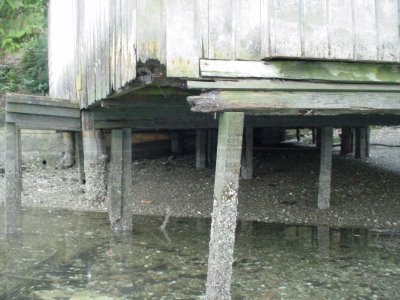 We returned to Oyster Bay, for another paddle this last weekend, this time with our son Taraz. One thing about Puget Sound - it has moods and nuiances that come with clouds, rain and sun. The last time we were here, it was very sunny, which made for deep color in all my photographs. This paddle was different, in weather that was quite subdued. All the colors became muted and soft.The water was still, hardly a ripple, with a few raindrops breaking the surface. We paddled completely around the bay, enjoying the sounds of gulls, the flocking up of Goldeneyes, White-winged Scoters, Mallards, and Buffelheads. There were quite a few shore birds, like 'Yellow-leggs' (similar to a Sandpiper). There were a few docks on the water that had oodles of clam shells that had been opened by gulls. Also, the Canadian Geese sun themselves on these docks, that is until we disturb them. Then, with a few wary glances and a communal agreement, they all heavily flap upwards with resounding squaks. They flew just far enough to settle in the water a short ways away.This is the bay where I video-taped the jellyfish a few weeks ago, and today they were pulsing along, just as precious as can be. I did a little video-taping, but oftentimes my camera just lingered on Taraz, bundled up in his big tan coat and hat, hunkered down in the middle of the canoe. I'm aware that as he gets older my opportunities to film him will be limited, so I just focused on him until my film ran out.
We returned to Oyster Bay, for another paddle this last weekend, this time with our son Taraz. One thing about Puget Sound - it has moods and nuiances that come with clouds, rain and sun. The last time we were here, it was very sunny, which made for deep color in all my photographs. This paddle was different, in weather that was quite subdued. All the colors became muted and soft.The water was still, hardly a ripple, with a few raindrops breaking the surface. We paddled completely around the bay, enjoying the sounds of gulls, the flocking up of Goldeneyes, White-winged Scoters, Mallards, and Buffelheads. There were quite a few shore birds, like 'Yellow-leggs' (similar to a Sandpiper). There were a few docks on the water that had oodles of clam shells that had been opened by gulls. Also, the Canadian Geese sun themselves on these docks, that is until we disturb them. Then, with a few wary glances and a communal agreement, they all heavily flap upwards with resounding squaks. They flew just far enough to settle in the water a short ways away.This is the bay where I video-taped the jellyfish a few weeks ago, and today they were pulsing along, just as precious as can be. I did a little video-taping, but oftentimes my camera just lingered on Taraz, bundled up in his big tan coat and hat, hunkered down in the middle of the canoe. I'm aware that as he gets older my opportunities to film him will be limited, so I just focused on him until my film ran out.
 There are many abandoned old shacks along Oyster Bay, which were used by fishermen decades ago. This one had moss and lichen growing all over the roof and barnacles stuck to the pilings. You can see that the tide has come all the way up to the flooring at times, probably making the building musty and moldy.Oyster bay is a pristine, healthy ecosystem, with clear water and much aquatic life. It is also one of the older neighborhoods - with many quaint little cabins built with rustic charm.
There are many abandoned old shacks along Oyster Bay, which were used by fishermen decades ago. This one had moss and lichen growing all over the roof and barnacles stuck to the pilings. You can see that the tide has come all the way up to the flooring at times, probably making the building musty and moldy.Oyster bay is a pristine, healthy ecosystem, with clear water and much aquatic life. It is also one of the older neighborhoods - with many quaint little cabins built with rustic charm.
 This shows the 'put in point' place, where we started, about 10:30 a.m. It shows high tide and the beginning of oysterbeds.
This shows the 'put in point' place, where we started, about 10:30 a.m. It shows high tide and the beginning of oysterbeds.
By the end of our paddle, the tide had gone out about 50 feet, and we had to walk on mudflats to get back. It was solid, though, not bad walking. We had to pull the canoe up an embankment, crawl through some blackberry canes, and pull the canoe along the road a ways to get to the van.















